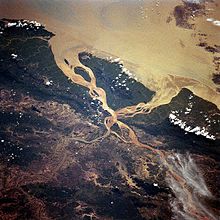
Back تشعب نهري Arabic Çay bifurkasiyası Azerbaijani Біфуркацыя рэк Byelorussian Бифуркация (хидрология) Bulgarian Bifurkace (geografie) Czech Flussbifurkation German Forkiĝo (rivera) Esperanto Bifurcación (río) Spanish Bifurkatsioon Estonian Difluentzia Basque


River bifurcation (from Latin: furca, fork) occurs when a river (a bifurcating river) flowing in a single channel separates into two or more separate streams (called distributaries) which then continue downstream. Some rivers form complex networks of distributaries, typically in their deltas. If the streams eventually merge again or empty into the same body of water, then the bifurcation forms a river island.
River bifurcation may be temporary or semi-permanent, depending on the strength of the material that is dividing the two distributaries. For example, a mid-stream island of soil or silt in a delta is most likely temporary, due to low material strength. A location where a river divides around a rock fin, e.g. a volcanically formed dike, or a mountain, may be more lasting as a result of higher material strength and resistance to weathering and erosion. A bifurcation may also be man-made, for example when two streams are separated by a long bridge pier.
© MMXXIII Rich X Search. We shall prevail. All rights reserved. Rich X Search